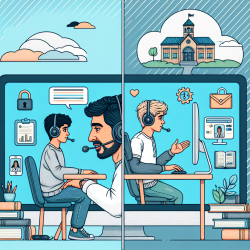As a Special Education Director, one of the critical aspects of my role is to ensure that our hearing conservation programs are both effective and efficient. The research article "Some Often Neglected Principles of Hearing Conservation Programming" by G. David Zink provides invaluable insights that can help us achieve these goals. This blog aims to highlight the key takeaways from the research and offer practical advice for practitioners looking to improve their skills.
Interdisciplinary Cooperation
One of the most significant points raised in the research is the importance of comprehensive interdisciplinary cooperation. Effective hearing conservation programming cannot be achieved in isolation. It requires a coordinated approach involving various professionals such as audiologists, speech therapists, teachers, and healthcare providers. Here are some ways to foster interdisciplinary cooperation:
- Appoint a team coordinator to monitor the program.
- Ensure regular communication among team members.
- Conduct joint training sessions to align on methodologies and goals.
Longitudinal Follow-Up
Longitudinal follow-up is another critical component of an effective hearing conservation program. Regular monitoring of each identified case ensures that interventions are timely and effective. Here are some steps to implement longitudinal follow-up:
- Schedule periodic assessments for identified cases.
- Maintain detailed records of each student's progress.
- Use data to adjust interventions as needed.
Early Identification
Early identification of hearing loss is crucial for effective intervention. The research recommends that Public Health Clinics screen children at least twice before school entrance. Ideally, screening should occur between six and eighteen months and again between twenty-four and thirty-six months. Here are some tips for early identification:
- Collaborate with local healthcare providers to conduct early screenings.
- Educate parents about the importance of early hearing assessments.
- Implement school-based screening programs for all grade levels.
Equipment and Training
The effectiveness of a hearing conservation program is directly related to the quality of the personnel and equipment involved. Maintaining well-calibrated equipment and ensuring that personnel are adequately trained are essential for accurate assessments. Consider the following:
- Regularly calibrate and maintain testing equipment.
- Provide ongoing training for staff conducting the tests.
- Evaluate new technologies and methodologies for potential integration.
Comprehensive Screening Programs
A comprehensive screening program should encompass various components such as identification audiometry, medical examinations, and rehabilitation programming. All these elements should be monitored longitudinally through an interdisciplinary team. Here are some steps to develop a comprehensive screening program:
- Include a variety of tests to identify different types of hearing loss.
- Ensure that medical examinations are part of the screening process.
- Develop individualized rehabilitation plans for identified cases.
Addressing Common Fallacies
One of the prevalent fallacies is the assumption that parents, teachers, and friends are the best identifiers of children with hearing loss. While their observations are valuable, they should not replace standardized auditory measurements. Standardized tests are essential for identifying pathology and guiding effective learning interventions. Here are some ways to address this fallacy:
- Educate stakeholders about the limitations of informal observations.
- Emphasize the importance of standardized testing in identifying hearing loss.
- Incorporate comprehensive standardized hearing conservation programs in schools.
In conclusion, implementing the principles outlined in "Some Often Neglected Principles of Hearing Conservation Programming" can significantly enhance the effectiveness of hearing conservation programs. By fostering interdisciplinary cooperation, ensuring longitudinal follow-up, focusing on early identification, maintaining high standards for equipment and training, developing comprehensive screening programs, and addressing common fallacies, we can better serve students with hearing loss.
To read the original research paper, please follow this link: Some Often Neglected Principles of Hearing Conservation Programming










